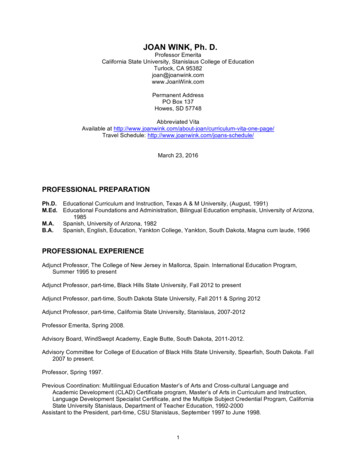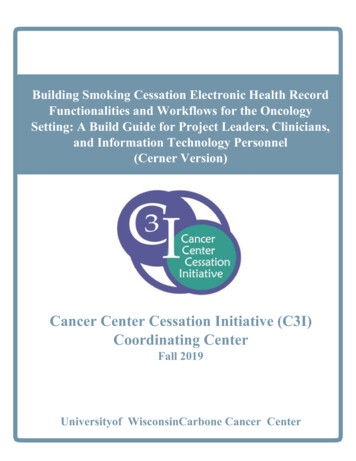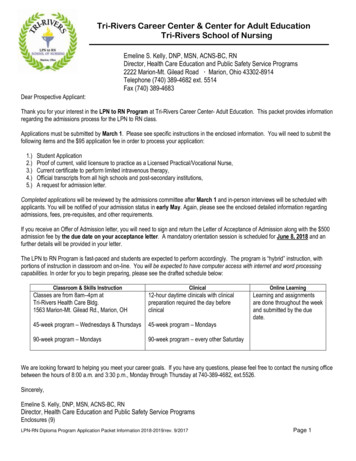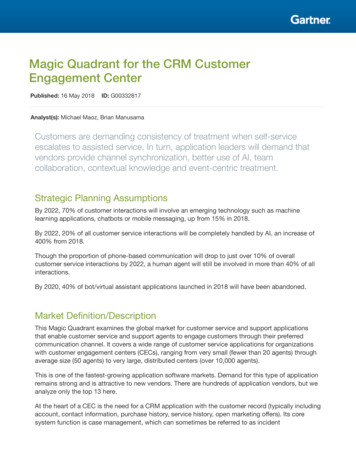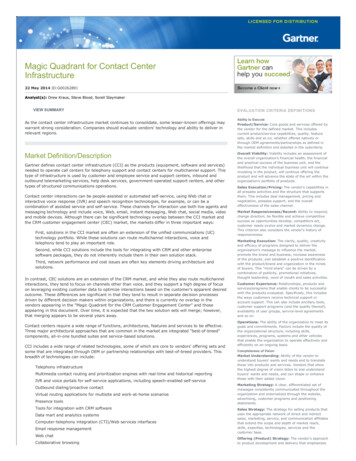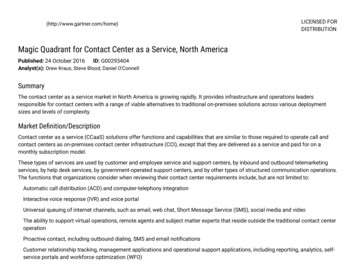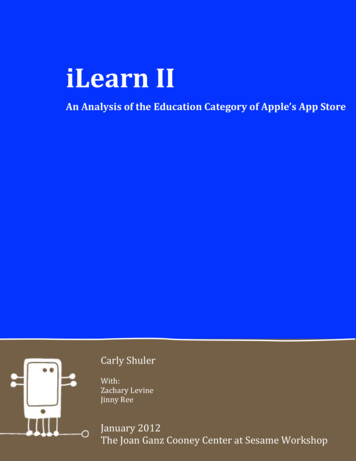
Transcription
ary2012TheJoanGanzCooneyCenteratSesameWorkshop1
k:TheJoanGanzCooneyCenteratSesameWorkshop.2
CT/SKILL- ORS30REFERENCES31ACKNOWLEDGEMENTS321
wouldspawnamultibillion- recentsampleoftop- developersofhigh- pmentandlearning;provideapubliclyaccessible,up- ‐to- ve.2
othintermsoftheiravailabilityandpopularity. ryoftheiTunesStoretargetchildren. easedtoalmostthree- ‐quarters(72%). ofthismarket. tegory(58%),andexperiencedthegreatestgrowth(23%). onsiderafairprice- ‐valueproposition. Theaveragepriceofchildren’sappshasrisenbyover antelevision,videogames,ortoys. werebasedonwell- ‐known,brandedcharacters. ildrenmayrepresentanimportantopportunity. edsigniJicantgrowth.3
ergrowthanddevelopmentofanecosystemrichwithhigh- otheirclaims(Shuler,2007).Thishasbeenalong- ffective,high- ‐qualityproducts.4
introduction5
dspawnamultibillion- reschoolandelementary- chnologytopic. Mobileapprevenueisexpectedtogenerate ndover300,000onAndroidTheAppStorehaspaidoutover fundsandintellectualresourcestowardpromisingapp- ampleoftop- developersofhigh- pmentandlearning;provideapubliclyaccessible,up- ‐to- ve.6
ADDRESSING THE “APP GAP”The Joan Ganz Cooney Center focuses attention on innovation in children’s learning through digital media, with aparticular focus on underserved children. While recognizing that the “latest technology market trends” often impact higherincome families more rapidly than our target audience, we are committed to analyzing new technologies and theirimplications for all kids, even when lower- income families’ engagement may lag behind by several years.Apps are a salient example of the creative tension we navigate. Few technologies have been touted as having as muchpotential for learning as touch-based mobile devices and the applications delivered through them. However, a recent studyby Common Sense Media documented an alarming new digital divide dubbed the “App Gap”, finding that more than a thirdof low-income parents do not know what an app is (Common Sense Media, 2011).As that study documents, for educational media producers trying to reach children most in need, the ubiquitous mediaplatform of a prior age—namely television—is still the best bet. However, as an organization devoted to potentialbreakthroughs in learning and healthy development, we will be continuing to track the app market as a high potentialopportunity for the following reasons:#1. The App Gap is likely to - systemsinlow- ia.#2. Media consumption should offer time well spent.Although children who currently have access to apps are often not those most in need of educational intervention, it stillmakes sense to turn their media time into high-quality experiences that promote learning and creativity—particularly for anation where performance in reading, math, and science is lagging behind other countries (NAEP, PISA and TIMMS).Considering children who do use mobile devices for media consumption spend an average of 43 minutes per day doing so(CommonSenseMedia, 2011), it makes sense to capitalize on this time by providing quality content.#3. Historical precedence may be repeated.Forty-five years ago, Joan Ganz Cooney charted new territory by proposing to use the power of television to educateunderserved preschoolers. Mrs. Cooney was galvanized in part by a critique from FCC Commissioner Newton Minow, whocharacterized television as a “vast wasteland.” Her response led to the creation of the Children’s Television Workshop andSesame Street, and in turn the revolutionary use of television as an educational medium. In this light, it is important thatwe do not discount technologies that have not yet made significant educational impact as not having the potential to do so.#4. Smart mobile devices and tablets are on the horizon for schools.The Horizon Report identifies mobile devices—especially smartphones and tablets—as one of six emerging technologieslikely to have a large impact on teaching, learning, research, or creative expression within K –12 education, and as one oftwo that are on the near-term horizon (under two years until usage in the educational community) to become mainstream(Johnson et. al., 2011). Once smart mobile devices are pervasive in schools, apps will have an entryway into the hands ofmany more children. The time to start considering how to harness this media as a powerful educational tool is now.7
Methods&Limitations8
rningapps,ananalysisofthetop- DS?Clearly,thisisacomplexmarket- netheEducationcategoryoftheleadingsourceforapps- ‐- odplacetostart.SAMPLECOMPILATIONThetop- includedthe100top- llowingcharacteristics:age,price,subject/skill- oolusage,andbranding.Inter- nsultedtwoexternalsources—Common1Fourapps were removed for the following reasons: 2 were in a foreign language, 1 was removed from iTunes before thesecond coding and 1 was clearly in the wrong category.9
recodedforthefollowingcharacteristics: hildren). eeappswereincludedinthedatabase. Subject/skill- ‐set:Whatsubjectorskill- ‐setdoesthisappaimtoteach?Subject/skill- hatwasconsideredthedominantsubject. Ifnot,itwastaggedasconsumeronly. nded.Ifnot,itwastaggedasnon- ‐branded. mersources: RatingsassignedbyCommonSenseMedia(Codes:1- ‐5stars,notrated) s:1- ‐5stars,notrated) CustomerratingoniTunes(Codes:1- ‐5,notrated) NumberofratingsoniTunes10
: thisdatabasearethosemarketedaseducational. MarketSegmentThisisananalysisofthetop- ppsincludeanalysesof: yoftheiTunesAppStore TheGamescategoryoftheiTunesAppStore TheeBooksectionoftheiTunesAppStore honewiththelargestmarketshare. rkettrendsidentiJiedinthereportremainedrelevant.11
Findings12
thetop- novativeorexceptionalc
1 iLearnII ��Apple’sApp’Store CarlyShuler With: ZacharyLevine JinnyRee January2012 The&Joan&
